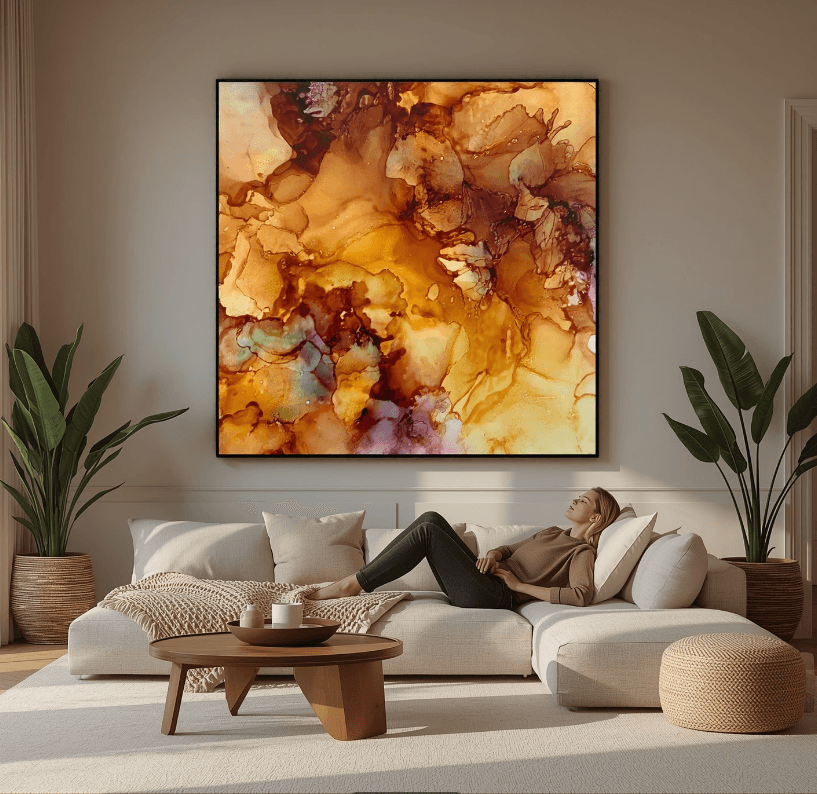The Science and Soul of Stress-Reducing Art

Transform Your Space, Transform Your Life
Your environment directly influences how you feel. When stress builds, even your home, your supposed safe space, can feel overwhelming. However, what if the art on your walls could offer relief, restore balance, and help you reconnect with yourself and your loved ones?
The Science of Stress-Reducing Art: Real Results, Tangible Benefits
At Temi Fine Arts & Family Wellness, LLC, I blend artistic beauty with scientific research to create Stress-Reducing Art. This is art that does more than decorate; it transforms. Each piece is designed using natural fractal patterns and intentional color placement, both scientifically shown to ease stress, enhance mental clarity, and create a sense of calm.
This is more than just art. It's a science-based and wellness tool for emotional connection and renewal.
We believe in evidence-based practices. Our work isn’t just created for visual appeal; it’s designed with intention, guided by research that demonstrates how specific visual elements can reduce stress and support emotional balance.
By aligning art with science, we provide more than beautiful paintings. We offer solutions that turn your environment into an ally for relaxation, clarity, and peace.

The Science of Stress-Reducing Art: Real Results, Tangible Benefits
Why Your Space Feels Heavy
Stress builds up not just in your mind and body, but also in your surroundings. When your environment isn’t designed for relaxation, it reflects that inner tension by draining your energy rather than replenishing it.
The solution? It's Intentional Art Placement, a proprietary method of positioning Stress-Reducing Art to create a space that works for you, not against you. By integrating fractal-inspired designs and nature-based colors, our art is embedded with scientifically proven images that lower stress levels, enhance emotional balance, and promote relaxation.
Explore the Research Behind Stress-Reducing Art
Discover the studies that validate the impact of Stress-Reducing Art and why intentional design is key to fostering a stress-free environment.
From Chaos to Calm: What Science Says About Stress-Reducing Art

Explore the research that inspires our art and confirms the
powerful impact it can have on mental and emotional well-being:
Richard Taylor, University of Oregon: Exposure to fractal patterns reduced stress levels by up to 60% within the first minute.
Stress Recovery with Nature Sounds and Visual Patterns
Dr. Dieter K. Reuter, University of Munich: Viewing natural fractals promotes faster stress recovery compared to urban environments.
Cortical Activity Changes in Response to Natural Fractals
Dr. Fredrick J. Bevis, Stanford University: Natural patterns significantly increase relaxation and support emotional regulation.
Art in Action: How My Art Transforms Spaces and Lives
Our stress-reducing art isn’t just research-backed—it’s been tested in real life.
When I started creating art for my son to help him focus during homeschooling, the results were incredible. Not only did he feel calmer and more focused, but the paintings also became a lifeline for my husband, who is a medical professional, by helping him unwind after long days. Together, we transformed our home into a sanctuary, one painting at a time.
Physiological Responses to Art: How Art Heals from the Inside Out
The interaction between art and physiology is real. Studies show that exposure to specific visual elements leads to measurable changes in stress levels and emotional well-being.
Openness to Experience and Aesthetic Chills: Links to Heart Rate
Marina Pavlova, University of Toronto: Viewing art decreased heart rate, indicating a reduction in stress.
Fractals and Human Physiological Complexity
Bruce J. West, Army Research Office: Fractal visual patterns align with human physiology, promoting relaxation and recovery.
The Influence of Art on Heart Rate Variability
Dr. Anna Brooks, Auckland University of Technology: Viewing art increased heart rate variability, a sign of improved resilience and reduced stress.

Art That Transforms Professional Spaces
Art isn’t just for homes—it’s essential in professional environments too. From healthcare settings to corporate offices, thoughtfully placed art promotes well-being, recovery, and productivity.
Healing Spaces: The Effects of Physical Environment on Health Outcomes
Dr. Esther Sternberg, University of Arizona: Patients in hospitals with art displayed required fewer pain medications and experienced less stress.
Impact of Visual Art on Mental Health in Workplaces
Dr. Craig Knight, University of Exeter: Employees in art-enhanced spaces reported lower stress and higher productivity.
How I Integrate Science with Art to Elevate Your Space

At Temi Fine Arts, every painting is an opportunity to blend science with soul. Whether it’s a custom piece for your home or artwork designed to uplift professional spaces, our mission is to create environments where peace, balance, and connection thrive.
Art that speaks to your heart, heals your mind, and transforms your space.
How I Integrate Science with Art to Elevate Your Space
Ready to experience the transformative power of art?
Explore the collection of downloadable calming, science-based artworks that can bring renewal into your environment.
Looking for something tailored to your unique space? Work with me to create a custom painting designed to meet your needs.
Experience the Change for Yourself
Your space should restore you, not drain you. Whether at home, in the office, or in a healthcare setting, you need art that is intentionally designed to unlock the peace and balance you’ve been searching for.
Take the first step today.

Art that speaks. Tools that heal. Coaching that transforms.
Open Hours
Mon-Fri: 9 AM – 4 PM
Saturday: Closed
Sunday: Closed
Location
Temi Fine Arts & Family Wellness, LLC.
P. O. Box 681806
Prattville, AL. 36068
Email: info@TemiAyodeji.com
© Copyright 2025 All Rights Reserved
Created with © systeme.io


